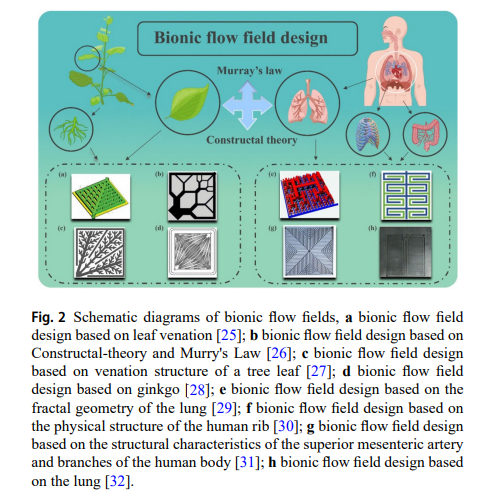Journal of Bionic Engineering (2025) 22:47–64 https://doi.org/10.1007/s42235-024-00607-2
Tongxi Zheng1
· Fanyu Meng2
· Wenxuan Fan1
· Mingxin Liu1
· Dafeng Lu1
· Yang Luan1
· Xunkang Su1
· Guolong Lu1
·
Zhenning Liu1
1 Key Laboratory of Bionic Engineering (Ministry of Education), College of Biological and Agricultural Engineering, Jilin University, Changchun 130022, China
2 Product Planning and Project Management Department, China FAW Group Corporation Limited, Changchun 130011, China
Abstract
Bipolar plate is one of the key components of Proton Exchange Membrane Fuel Cell (PEMFC) and a reasonable flow field design for bipolar plate will improve cell performance. Herein, we have reviewed conventional and bionic flow field designs in recent literature with a focus on bionic flow fields. In particular, the bionic flow fields are summarized into two types: plant-inspired and animal-inspired. The conventional methodology for flow field design takes more time to find the optimum since it is based on experience and trial-and-error methods. In recent years, machine learning has been used to optimize flow field structures of bipolar plates owing to the advantages of excellent prediction and optimization capability. Artificial Intelligence (AI)-assisted flow field design has been summarized into two categories in this review: single-objective optimization and multi-objective optimization. Furthermore, a Threats-Opportunities-WeaknessesStrengths (TOWS) analysis has been conducted for AI-assisted flow field design. It has been envisioned that AI can afford a powerful tool to solve the complex problem of bionic flow field design and significantly enhance the performance of PEMFC with bionic flow fields.
Keywords Proton exchange membrane fuel cell · Artificial intelligence · Bionic · Flow field · Algorithm

Copyright © 2025 International Society of Bionic Engineering All Rights Reserved
吉ICP备11002416号-1









